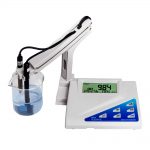what is pH Meter Laboratory? pH meter is used as a tool to determine the acidity and alkalinity of a solution. In addition to the solution, pH meters can also be used on the soil to see if the soil can be used for humans to grow crops, research, even just to know the mineral level in the soil with further calculations.
Types of pH meter in laboratory are various, there is a simple or the online one that can measure the conductivity of the solution. Laboratory pH meter functions vary. The pH Meter Laboratory functions are various, such as :
- In Senior High School, pH meter is commonly used during practicum-making simple acid-alkaline solutions and to determine the pH of acidic fruits.
- In the college, pH meters are widely used. Such as measuring the pH of a standard solution, making a buffer solution,(Read also Buffer Capacity) making a solution for research that requires a certain pH, knowing the soil acidity and so on.
- In the industrial world, especially those involving water and land the use of pH meters is wider. Suppose that in the steam power station (PLTU), the acidic level of water that is used should always be monitored to avoid rust causing leaks in the pipes in the steam power station. Then, measure the conductivity that has the Siemens unit. If the conductivity value is high,so the level of total Total Suspended Solids (TSS) and Total Dissolved Solids (TDS) are high. Beside that, TDS and TSS level in the PLTU industry, so that in the drinking water industry, TDS and TSS levels are very important to control. If the levels are very high, it can cause poisoning for those who consume them. Thus, that’s the pH Meter Laboratory functions.
Related article :
The Definition of TDS and TSS
What are TDS and TSS? Is there anything to do with pH Meter Laboratory Function? The answer is of course there. TDS is an unfiltered solid on a filter paper having a 0.45 micrometer in size. While TSS is a small solid that can still be retained on filter paper measuring 0.45 micrometer. Examples of TDS are like Na +, Fe2 +, CO32-, SO42-, and so on.
While TSS examples such as Fe3O4, NaCl, CaCO3 which has a large enough particle. The ions cause the high or low pH value of a solution or the soil. Suppose we discussed in solution. If the Ca2 + level is high then the solution will be alkaline. And suppose the Fe3O4 level is high, then the water will be acidic.
But to note that pH meter can not measure TDS and TSS levels. TSS and TDS levels only have an effect on the pH and the conductivity directly on the solution. TDS and TSS can be measured with a variety of other instruments such as ion chromatography, AAS, Spectrophotometer and so on.
Thus the complete explanation of the pH Meter Laboratory functions. Hope it may be useful. Let’s learn chemistry better here!

